ZEN MESTEREK ZEN MASTERS
« Zen főoldal
« vissza a Terebess Online nyitólapjára
Jeffrey Lyle Broughton (1944-)
Jeffrey L. Broughton is Professor of Religious Studies at the University of California, Long Beach. Professor Broughton's specialty is Buddhist Studies (early Ch'an texts). He has a B.A. from Columbia College in English Literature and Oriental Studies and an M.A. and Ph.D. in Classical Chinese from Columbia's Department of East Asian Languages and Cultures.
PDF: Early Ch'an Schools of Tibet
by Jeffrey L. Broughton
in: Studies in Ch'an and Hua-yan, edited by Robert M. Gimello and Peter N. Gregory. pp. 1-68.
The Kuroda Institute: Studies in East Asian Buddhism No. 1. Honolulu: University of Hawaii Press, 1983.
A summary of research on the Ch'an from Szechwan that influenced Tibet in the 750s to 780s A.D. The Ching-chung Ch'an of the Korean monk Mu-sang (Wu-hsiang) was the first to reach Tibet. It was soon followed by the competing Ch'an of the Pao-t'ang "school" of Wu-chu. Therefore when the Nothern Ch'an master Mo-ho-yen arrived in Tibet, he had to compromise with Pao-t'ang doctrine and adopt some of its pseudo-history in order to gain a hearing among the Ch'an followers he was asked to represent.
There is also some discussion of a third Ch'an lineage in Tibet, a Pure Land-style Ch'an. The article concludes with hints for further research which may reveal the contribution Ch'an made to the rDzogs-chen "school" which preserves many Ch'an works in Tibetan translation.
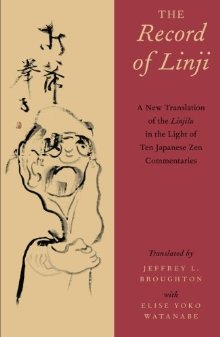
The Record Of Linji: A New Translation Of The Linjilu In The Light Of Ten Japanese Zen Commentaries
by Jeffrey L. Broughton with Elise Yoko Watanabe
Oxford University Press Inc, 2012, 336 p.
The Linjilu (Record of Linji or LJL) is one of the foundational texts of Chan/Zen Buddhist literature, and an accomplished work of baihua (vernacular) literature. Its indelibly memorable title character, the Master Linji—infamous for the shout, the whack of the rattan stick, and the declaration that sutras are toilet paper—is himself an embodiment of the very teachings he propounds to his students: he is a "true person," free of dithering; he exhibits the non-verbal, unconstrained spontaneity of the buddha-nature; he is always active, never passive; and he is aware that nothing is lacking at all, at any time, in his round of daily activities. This bracing new translation transmits the LJL 's living expression of Zen's "personal realization of the meaning beyond words," as interpreted by ten commentaries produced by Japanese Zen monks, over a span of over four centuries, ranging from the late 1300s, when Five-Mountains Zen flourished in Kyoto and Kamakura, through the early 1700s, an age of thriving interest in the LJL. These Zen commentaries form a body of vital, in-house interpretive literature never before given full credit or center stage in previous translations of the LJL. Here, their insights are fully incorporated into the translation itself, allowing the reader unimpeded access throughout, with more extensive excerpts available in the notes. Also provided is a translation of the earliest extant material on Linji, including a neglected transmission-record entry relating to his associate Puhua, which indicate that the LJL is a fully-fledged work of literature that has undergone editorial changes over time to become the compelling work we know today.
Table of Contents
Acknowledgments
Abbreviations
Introduction
Translation of the Linjilu
Part I: Dharma-Hall Convocations
Part II: Sangha Instruction
Part III: Calibrating and Adjudicating
Part IV: Record of the Karman of the Master's Career
Part V: Stupa Record of Chan Master Linji Huizhao
Yuanjue Zongyan's Xuanhe 2 (1120) Linjilu Edition (LJL)
Appendix 1: Pre-Song Linji and Puhua Sayings and Episodes Preserved in the Collection of the Patriarchal Hall (Zutangji)
Appendix 2: Pre-Song Linji Sayings Preserved in the Mind-Mirror Record (Zongjinglu)
Notes
Bibliography
Index
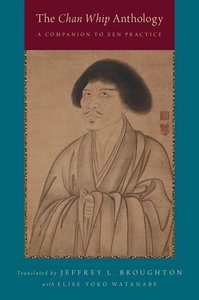
PDF: The Chan Whip Anthology > PDF
Translated by Jeffrey L. Broughton with Elise Yoko Watanabe
New York : Oxford University Press, 2014.
https://cloudflare-ipfs.com/ipfs/bafykbzacecdhddxxccml44apg37euleujf6jrnm6tvspjo6unm6ra5fqoqlt4?filename=Jeffrey%20L.%20Broughton%2C%20Elise%20Yoko%20Watanabe%20-%20The%20Chan%20Whip%20Anthology_%20A%20Companion%20to%20Zen%20Practice-Oxford%20University%20Press%20%282014%29.pdf
禪關策進 Changuan cejin [Progress in the Path of Chan / Chan Whip]
"The Chan Whip (C. Changuan cejin, K. Songwan chaekchin, J. Zenkan sakushin, magyar: Csan ösztöke) is a work that played a major role in the revival of gongan (K. kongan, J. koan) practice that swept the Chan, Son, and Zen schools of Buddhism in East Asia in the seventeenth century, and its influence continues to be felt down to the present. Jeffrey Broughton provides a clear and consistent translation of this inspiring but difficult work, together with a critical apparatus that is well-designed to make it as accessible as possible to a Western audience. Scholars and practitioners alike can benefit greatly from his philological expertise and sensitive interpretations of the material." - T. Griffith Foulk, Professor of Religion, Sarah Lawrence CollegeSummary
Jeffrey L. Broughton offers an annotated translation of the Whip for Spurring Students Onward Through the Chan Barrier Checkpoints, which he abbreviates to Chan Whip. This anthology is a classic of Chan (Zen) Buddhism that has served as a Chan handbook in both China and Japan since its publication in 1600. It is a compendium of extracts, over eighty percent of which are drawn from an enormous Chan corpus dating from the late 800s to about 1600-a survey that covers most of the history of Chan literature. The rest of the text consists of complementary extracts from Buddhist sutras and treatises. The extracts, many of which are accompanied by Chan master Dahui Zhuhong's commentary, deliberately eschew abstract discussions of theory in favor of sermons, exhortations, sayings, autobiographical narratives, letters, and anecdotal sketches dealing frankly and compassionately with the concrete experiences of lived practice. While there are a number of publications in English on Zen practice, none contain the vivid descriptions found within the Chan Whip. This translation thus fills a large gap in the English -language literature on Chan, and by including the original Chinese text as well Broughton has produced an invaluable tool for scholars and practitioners alike.
Contents
-- Abbreviations -- Introduction -- Whip for Spurring Students Onward Through the Chan Barrier Checkpoints -- Preface to Whip for Spurring Students Onward Through the Chan Barrier Checkpoints -- Front Collection: The First Gate -- Front Collection: The Second Gate -- Back Collection: Single Gate -- Chinese Text of Changuan cejin -- Bibliography.
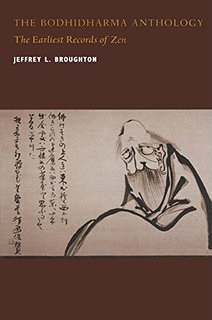
PDF: The Bodhidharma Anthology: The Earliest Records of Zen
by Jeffrey L Broughton
University of California Press, 1999
Scanned PDF
Table of Contents
| Acknowledgments | ||
| Abbreviations and Conventions | ||
| 1 | Introduction | 1 |
| 2 | Translation of the Seven Texts of the Bodhidharma Anthology | 8 |
| 3 | Commentary on the Biography, Two Entrances, and Two Letters | 53 |
| 4 | Commentary on the Records | 76 |
| App. A | The Stratigraphy of the Tun-Huang Ch'an Manuscripts | 96 |
| App. B | Toward a Literary History of Early Ch'an | 105 |
| Notes | 119 | |
| Glossary of Chinese Logographs | 165 | |
| Works Cited | 169 | |
| Index | 175 |
In the early part of this century, the discovery of a walled-up cave in northwest China led to the retrieval of a lost early Ch'an (Zen) literature of the T'ang dynasty (618-907). One of the recovered Zen texts was a seven-piece collection, the Bodhidharma Anthology . Of the numerous texts attributed to Bodhidharma, this anthology is the only one generally believed to contain authentic Bodhidharma material.
Jeffrey L. Broughton provides a reliable annotated translation of the Bodhidharma Anthology along with a detailed study of its nature, content, and background. His work is especially important for its rendering of the three Records, which contain some of the earliest Zen dialogues and constitute the real beginnings of Zen literature.
The vivid dialogues and sayings of Master Yuan, a long-forgotten member of the Bodhidharma circle, are the hallmark of the Records . Master Yuan consistently criticizes reliance on the Dharma, on teachers, on meditative practice, and on scripture, all of which lead to self-deception and confusion, he says. According to Master Yuan, if one has spirit and does not seek anything, including the teachings of Buddhism, then one will attain the quietude of liberation. The boldness in Yuan's utterances prefigures much of the full-blown Zen tradition we recognize today.
Broughton utilizes a Tibetan translation of the Bodhidharma Anthology as an informative gloss on the Chinese original. Placing the anthology within the context of the Tun-huang Zen manuscripts as a whole, he proposes a new approach to the study of Zen, one that concentrates on literary history, a genealogy of texts rather than the usual genealogy of masters.
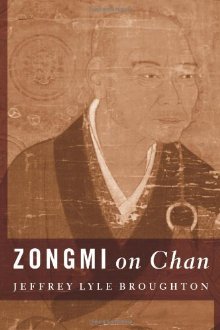
PDF: Zongmi on Chan
by
Jeffrey Lyle Broughton
New York : Columbia University (Translations from the Asian classics), 2009, xv, 348 p.
Japanese Zen often implies that textual learning (gakumon) in Buddhism and personal experience (taiken) in Zen are separate, but the career and writings of the Chinese Tang dynasty Chan master Guifeng Zongmi (780-841) undermine this division. For the first time in English, Jeffrey Broughton presents an annotated translation of Zongmi's magnum opus, the Chan Prolegomenon, along with translations of his Chan Letter and Chan Notes.
The Chan Prolegomenon persuasively argues that Chan "axiom realizations" are identical to the teachings embedded in canonical word and that one who transmits Chan must use the sutras and treatises as a standard. Japanese Rinzai Zen has, since the Edo period, marginalized the sutra-based Chan of the Chan Prolegomenon and its successor text, the Mind Mirror (Zongjinglu) of Yongming Yanshou (904-976). This book contains the first in-depth treatment in English of the neglected Mind Mirror, positioning it as a restatement of Zongmi's work for a Song dynasty audience.
The ideas and models of the Chan Prolegomenon, often disseminated in East Asia through the conduit of the Mind Mirror, were highly influential in the Chan traditions of Song and Ming China, Korea from the late Koryo onward, and Kamakura-Muromachi Japan. In addition, Tangut-language translations of Zongmi's Chan Prolegomenon and Chan Letter constitute the very basis of the Chan tradition of the state of Xixia. As Broughton shows, the sutra-based Chan of Zongmi and Yanshou was much more normative in the East Asian world than previously believed, and readers who seek a deeper, more complete understanding of the Chan tradition will experience a surprising reorientation in this book.Transliteration Systems
Abbreviations
Introduction
1. Translation of the Chan Letter
2. Translation of the Chan Prolegomenon
3. Translation of the Chan Notes
Appendix 1. Editions Used in the Translations
Appendix 2. Pei Xiu's Preface to the Chan Prolegomenon in the Wanli 4 (1576) Korean Edition
Appendix 3. Song Dynasty Colophon to the Chan Prolegomenon as Reproduced in the Wanli 4 (1576) Korean Edition
Notes
Glossary of Chinese Characters
Bibliography
IndexBroughton, J.,
Tsung-mi's Zen Prolegomenon: Introduction to an Exemplary Zen Canon.
In: The Zen Canon: Understanding the Classic Texts. (Eds. S. Heine & D. S. Wright), 2004.
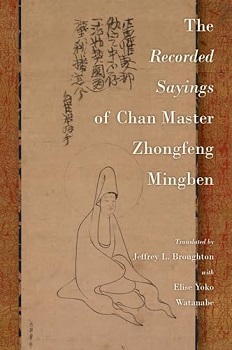
PDF: The Recorded Sayings of Chan Master Zhongfeng Mingben
by Jeffrey L. Broughton with Elise Yoko Watanabe
Oxford University Press, 2023
Contents
Abbreviations ix
Introduction 1
Linji Chan in the South During the Mongol Yuan Dynasty: Zhongfeng Mingben and Yuansou Xingduan 1
Autobiography and Huatou Chan 7
The Format and Underlying Theme of Zhongfeng’s Autobiography 10
The Confining Bureaucratic Chan Style of Mt. Tianmu Versus the Unencumbered Chan Style of a Vagabond Budai (布袋) 14
Two Chan Records for Zhongfeng Mingben: Zhongfeng Extensive Record and Zhongfeng Record B 17
Understanding the Phantasmal (zhi huan 知幻) 23
Detaching from the Phantasmal (li huan 離幻): The Huatou 27
Zhongfeng’s Great Matter of Samsara (shengsi dashi 生死大事) 30
Zhongfeng: “I Am Not Awakened” 32
Entanglement of Huatou Chan and Pure Land Nianfo (Nembutsu): Zhongfeng and Tianru 35
Zhongfeng and the “Nanzhao” (Yunnan) Pilgrim Xuanjian (玄鍳; d.u.) 38
Zhongfeng and Japanese Zen 43
Zhongfeng, Tianru, and Ming- Dynasty Linji Chan 55
Translation 1: Selections from Instructions to the Assembly in Zhongfeng Extensive Record 63
Translation 2: Selections from Dharma Talks in Zhongfeng Extensive Record 71
Translation 3: Night Conversations in a Mountain Hermitage in Zhongfeng Extensive Record 83
Translation 4: House Instructions for Dwelling- in- the- Phantasmal Hermitage in Zhongfeng Extensive Record 168
Translation 5: In Imitation of Hanshan’s Poems in Zhongfeng Extensive Record 179
Translation 6: Song of Dwelling- in- the- Phantasmal Hermitage in Zhongfeng Extensive Record 212
Translation 7: Cross- Legged Sitting Chan Admonitions (with Preface) in Zhongfeng Extensive Record 214
Translation 8: Ten Poems on Living on a Boat in Zhongfeng Extensive Record 216
Translation 9: Ten Poems on Living in Town in Zhongfeng Extensive Record 220
Translation 10: Selections from Zhongfeng Dharma Talks in Zhongfeng Record B 225
Translation 11: Instructions to the Assembly from Zhongfeng Talks in Zhongfeng Record B 245
Chinese Text for Translation 1: Selections from Instructions to the Assembly in Zhongfeng Extensive Record 247
Chinese Text for Translation 2: Selections from Dharma Talks in Zhongfeng Extensive Record 250
Chinese Text for Translation 3: Night Conversations in a Mountain Hermitage in Zhongfeng Extensive Record 254
Chinese Text for Translation 4: House Instructions for Dwelling-in-the-Phantasmal Hermitage in Zhongfeng Extensive Record 280
Chinese Text for Translation 5: In Imitation of Hanshan’s Poems in Zhongfeng Extensive Record 284
Chinese Text for Translation 6: Song of Dwelling- in- the- Phantasmal Hermitage in Zhongfeng Extensive Record 294
Chinese Text for Translation 7: Cross- Legged Sitting Chan Admonitions (with Preface) in Zhongfeng Extensive Record 295
Chinese Text for Translation 8: Ten Poems on Living on a Boat in Zhongfeng Extensive Record 296
Chinese Text for Translation 9: Ten Poems on Living in Town in Zhongfeng Extensive Record 298
Chinese Text for Translation 10: Selections from Zhongfeng Dharma Talks in Zhongfeng Record B 300
Chinese Text for Translation 11: Instructions to the Assembly from Zhongfeng Talks in Zhongfeng Record B 309
Bibliography 311
Index 315
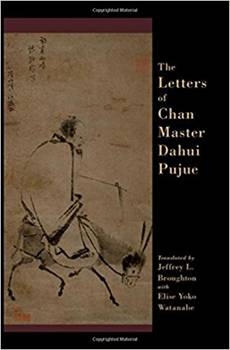
PDF: The Letters of Chan Master Dahui Pujue
Jeffrey L. Broughton, Elise Yoko Watanabe
Translator: Jeffrey L. Broughton
Oxford, England: Oxford University Press, August 2017. 408 p.
Review by Jason Protass, Assistant Professor of Religious Studies at Brown University
Broughton and Watanabe's The Letters of Chan Master Dahui Pujue (hereafter “Broughton” and Letters) is the first complete English rendition of a collection of Chinese letters that circulated across East Asia. The epistles by Dahui (1089-1163) are one of the world's richest religious documents, containing profound discussions on faith, the importance of doubt, paradoxes of spiritual effort, and messages of transformation. The translators' sophisticated textual apparatus, including footnotes that selectively translate from historical Korean and Japanese commentaries, makes this book indispensable for future studies of Dahui's letters.
Dahui was heralded by later traditions as the genius innovator of the kanhua meditative technique (Jap. kanna zen; K. kanhwa Sŏn) of examining the “head word” of a gong'an (“public case,” Jap. kōan). This kanhua practice as taught in the Letters is the root of modern popular understanding of “Zen koans” as riddles to disrupt discursive thought. Dahui, kanhua , and gong'an have each been frequent topics of scholarship. As Miriam Levering noted in her PhD dissertation (Harvard, 1978), Dahui's epistolary teachings have an enduring allure because they were addressed to the concerns of lay people.
Excerpts from Dahui's epistles were previously translated by Christopher Cleary in Swampland Flowers (Grove Press, 1977). Cleary worked from the text of Zhi yue lu 指月錄 (“A Record of Fingers Pointing at the Moon”), a late 16th century anthology whose compiler abridged Dahui's letters to their pith. One of the strengths of the Broughton translation was the choice to follow a complete early Gozan edition. Cleary's translation, despite the lack of a scholarly apparatus and the interesting choice of using an abridged Ming recension, is accessible, fluent, and generally accurate. By comparison, Broughton's style is terse and closely follows Chinese idioms.
The most original and likely enduring contributions of this book are its robust footnotes emphasizing historical exegeses of the epistles. The exegetical tradition is indispensable for interpreting thorny passages of epistolary Late Middle Chinese. The translators closely engage two Korean commentaries used in Sŏn seminaries since the 18th century—one by Chin'gak Hyesim (1178-1234) and an anonymous lexicon—in addition to one pre-modern Japanese commentary, two early modern Japanese commentaries, and several contemporary Japanese translations. Foremost in significance for the translators is perhaps Daie Fukaku zenji sho kōrōju 大慧普覚禅師書栲栳珠 (hereafter Kōrōju) produced by Japanese monk Mujaku Dōchū 無著道忠 (1653-1745), an erudite Zen monk and an expert on Song and Yuan era Chan. The translators present persuasive arguments when choosing to deviate from Mujaku's interpretations. Araki Kengo's authoritative 1969 annotated modern Japanese translation also relied on Kōrōju . The translators document their divergences from Araki as well. The result is an original work of interpretation that is profoundly informed by the Korean and Japanese traditions of exegesis and practice. This is a great achievement.
Broughton's emphasis on Korean and Japanese receptions situates the Letters more within the field of Zen Studies than within the study of Chinese religions. As a result, there is more work to be done to study how Chan epistles participated in the broader culture of Chinese letters. Natasha Heller has already provided a foundational essay on monastic letters during the Southern Song and Yuan dynasties, “Halves and Holes: Collections, Networks, and Epistolary Practices of Chan Monks” (in A History of Chinese Letters and Epistolary Culture , Brill, 2015). Also related is Huang Qijiang's Bei Song Huanglong Huinan Chanshi sanyao 北宋黃龍慧南禪師三鑰 (Taibei: Taiwan xuesheng shuju, 2015), which meticulously analyzes another set of Song era epistles with transnational circulation.
Dahui often crafted new ways of speaking while simultaneously engaging the expressions of earlier Chan masters. Perhaps it is fitting then that Broughton has experimented with English expressions, and at times deviated from well-tried translations. Some neologisms are clever. For example, an explanation of Dahui's idiosyncratic use of the verb guandai 管帶 is developed based on a gloss from Mujaku's Kōrōju . This yields the unusual “to continuously ‘engird mind' ” (18) as a description of wrong-headed effortful concentration of the mind. This mental girdle plays with the etymology of the second character in guandai : dai is literally to fasten or to belt on. (Rather than “engirding mind” I might have preferred “girding the mind,” which would resonate with the dated but idiomatic “gird the soul.”) Elsewhere, rendering mozhao 默照 as “silence-as-illumination,” well known to both scholarly and practitioner communities as “silent illumination,” recasts the term in the pejorative way Dahui himself treated mozhao . Other neologisms may distract. The genre of texts known as yulu is familiar as “recorded sayings.” The authors' preferred “sayings record” seems to introduce a distinction without a difference.
Letters begins with an introductory essay by Broughton that foregrounds compelling speculation about the centrality of the layman Huang Wenchang as “editor-in-chief.” (6) The authors also contend that Dahui may have taught huatou meditation practice to lay people exclusively. With negligible exceptions, they claim, there is no evidence that Dahui recommended huatou to his monastic disciples. (10-12) If correct, the implications would be that later traditions adapted a lay practice into a monastic one—contra Dahui's own praxis.
One brief correction. It is misleading to assert that Dahui was abbot of “the foremost of the official ‘Five-Mountains' Chan monasteries” (5-6) because the Five Mountains patronage system was only established in the first decades of the 13th century, after Dahui's life.
Despite such minor quibbles and stylistic preferences, this book is a wonderful resource to all who would read Dahui's epistles. The inclusion of lucid translations from multiple historical commentaries—a rich exegetical apparatus—is a great contribution. We are all indebted to the translators' work.
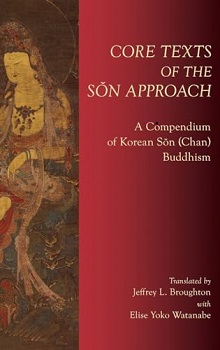
PDF: Core Texts of the Sŏn Approach: A Compendium of Korean Sŏn (Chan) Buddhism
by Jeffrey L. Broughton with Elise Yoko Watanabe
Oxford University Press, 2020
Jeffrey L. Broughton here offers a study and partial translation of Core Texts of the Sŏn Approach (Sŏnmun ch'waryo), an anthology of texts foundational to Korean Sŏn (Chan/Zen) Buddhism. Core Texts of the Sŏn Approach provides a convenient entrée to two fundamental themes of Korean Sŏn: Sŏn vis-à-vis the doctrinal teachings of Buddhism (in which Sŏn is shown to be superior) and the huatou (i.e., phrase; Korean hwadu) method of practice-work originally popularized by the Song dynasty Chinese Chan master Dahui Zonggao. This method consists of "raising to awareness" or "keeping an eye on" the phrase, usually No (Korean mu). No mental operation whatsoever is to be performed upon the phrase. One lifts the phrase to awareness constantly, when doing "quiet" cross-legged sitting as well as when immersed in the "noisiness" of everyday life. Core Texts of the Sŏn Approach, which was published in Korea during the first decade of the twentieth century, contains eight Chan texts by Chinese authors (two translated here) and seven Sŏn texts by Korean authors (three translated here), showing the organic relationship between the parent Chinese tradition and its Korean inheritor. The set of translations in this volume will give readers access to some of the key texts of the Korean branch of this influential East Asian school of Buddhism.